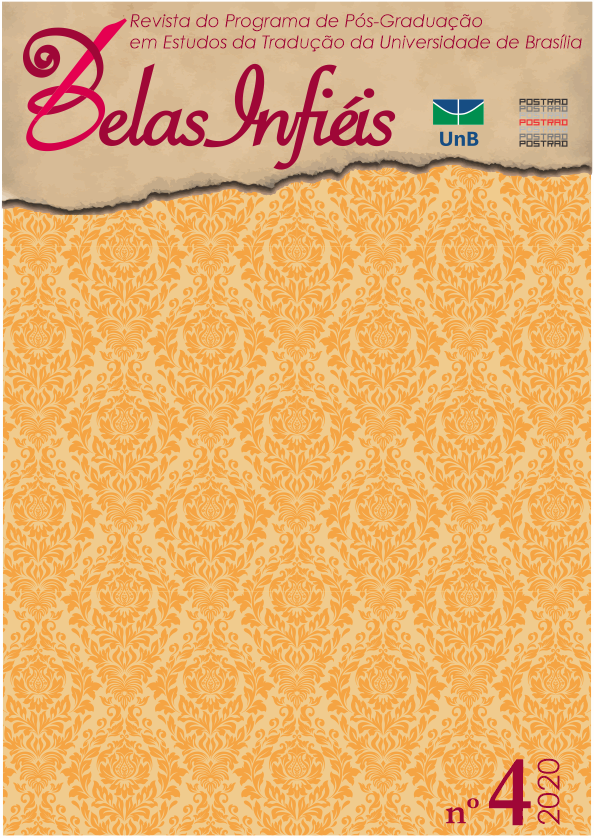Localização
DOI:
https://doi.org/10.26512/belasinfieis.v9.n4.2020.26401Palavras-chave:
Internacionalização. Localização. Tradução. Engenharia de software.Resumo
Localização é um hiperônimo que se refere ao processo através do qual conteúdos e produtos digitais desenvolvidos em determinada localidade são adaptados para uso e comercialização em outras localidades. Apesar de o termo “localização” ser utilizado desde o começo da década de 1980, sua definição ainda permanece confusa. Para entender o que é localização, é necessário considerar quando, como e por que surgiu, o que mudou ao longo dos anos e sua relação com a tradução e a internacionalização. Nesse contexto, este texto examina a localização e sua evolução dos anos de 1980 até o presente.
Downloads
Referências
BARTLETT, P.G. The benefits of structured XML authoring for content management. In: Graphic Communications Association (U.S.); Organization For The Advancement Of Structured Information Systems (OASIS) (Ed.). XML 98 Conference Proceedings. Chicago, IL/New York: Graphic Communications Association, 1998. p. 15-18.
BELLAMY, Laura; CAREY, Michelle, SCHLOTFELDT, Jenifer. DITA best practices: A roadmap for writing, editing, and architecting in DITA. Upper Saddle River, NJ: IBM Press, 2012.
BIAU GIL, José R.; PYM, Anthony. Technology and translation (A pedagogical overview). In: PYM, Anthony, PEREKRESTENKO, Alexander, STARINK, Bram (Ed.). Translation technology and its teaching. Tarragona, Spain: Intercultural Studies Group, 2006. p. 5-19.
BOEHM, Barry W. Software engineering economics. Englewood Cliffs, NJ: Prentice-Hall, 1981.
CADIEUX, Pierre; ESSELINK, Bert. GILT: Globalization, Internationalization, Localization, Translation. Globalization Insider, n. 11, [s.p.], 2002.
CLARK, Dan. Beginning C# object-oriented programming. [s.e.]: Apress, 2013. doi: https://doi.org/10.1007/978-1-4302-4936-8
DEITSCH, Andy; CZARNECKI, David. Java internationalization. Sebastopol, CA: O’Reilly, 2001.
DUNNE, Keiran J. Putting the Cart behind the Horse: Rethinking localization quality management. In: DUNNE, Keiran J. (Ed.). Perspectives on localization. Amsterdam and Philadelphia: John Benjamins, 2006. p.1-11. doi: https://doi.org/10.1075/ata.xiii.08dun
DUNNE, Keiran J. Assessing software localization: For a valid approach. In: ANGELLI, Claudia V.; JACOBSON, Holly E. (Ed.). Testing and assessment in translation and interpreting studies. Amsterdam and Philadelphia: John Benjamins, 2009. p. 185-222. doi: https://doi.org/10.1075/ata.xiv.10dun
DUNNE, Keiran J.; DUNNE, Elena S. Translation and localization project management: The art of the possible. Amsterdam and Philadelphia: John Benjamins, 2011. https://doi.org/10.1075/ata.xvi
DUNNE, Keiran J. Localization. In: SIN-WAI, Chan. The Routledge encyclopedia of translation technology, 2015. p. 550-562.
ESSELINK, Bert. A Practical guide to localization. Amsterdam and Philadelphia: John Benjamins, 2000a.
ESSELINK, Bert. Translation versus localization. Tranfree, v. 10, [s.p.], 2000b.
ESSELINK, Bert. Localization engineering: The Dream Job? Revista Tradumà tica, n. 1, p. 2-5, 2002.
ESSELINK, Bert. Localisation and translation. In: SOMERS, Harold L. (Ed.). Computers and translation: A translator’s guide. Amsterdam and Philadelphia: John Benjamins, 2003a. p. 67-86. doi: https://doi.org/10.1075/btl.35.08ess
ESSELINK, Bert. The evolution of localization. The guide to localization. Supplement to MultiLingual Computing and Technology, v. 14, n. 5, p. 4-7, 2003b.
GIAMMARRESI, Salvatore. Strategic views on localization project management: The importance of global product management and portfolio management. In: DUNNE, Keiran J.; DUNNE, Elena S. (Ed.). Translation and localization project management: The art of the possible. Amsterdam and Philadelphia: John Benjamins, 2011. p. 17-49. doi: https://doi.org/10.1075/ata.xvi.03gia
HALL, Patrick A.V. Software internationalization architectures. In: KERSTEN, Gregory E., MIKOLAJUK, Zbigniew; GAR-ON YEH, Anthony. (Ed.). Decision support systems for sustainable development in developing countries: A resource book of methods and applications. Boston, MA: Kluwer Academic Publishers, 1999. p. 291-304. doi: https://doi.org/10.1007/0-306-47542-1_16
LIEU, Tina. Software localization: The art of turning Japanese. Computing Japan, v. 4, n. 12, [s.p.], 1997.
LOMMEL, Arle. The globalization industry primer. Romainmôtier, Switzerland: Localization Industry Standards Association, 2007.
LUONG, Tuoc V.; LOK, James S. H.; TAYLOR, David J.; DRISCOLL, Kevin. Internationalization: Developing software for global markets. New York: John Wiley & Sons, 1995.
MARGULIES, Benson I. Your passport to proper internationalization. Dr Dobb’s, [s.p.], 1 maio 2000.
RAYNER, Keith; SERENO, Sara C. Eye movements in reading: Psycholinguistic studies. In: GERNSBACHER, Morton A. (Ed.). Handbook of psycholinguistics. San Diego, CA: Academic Press, 1994. p. 57-81.
ROCKLEY, Ann; KOSTUR, Pamela; MANNING, Steve. Managing enterprise content: A unified content strategy. Indianapolis: New Riders, 2003.
SAVOUREL, Yves. XML internationalization and localization. Indianapolis: Sams, 2001. doi: https://doi.org/10.1162/109966202760152149
SCHMITZ, Klaus-Dirk. Indeterminacy of terms and icons in software localization. In: ANTIA, Bassey E. (Ed.). Indeterminacy in terminology and LSP. Amsterdam and Philadelphia: John Benjamins, 2007. p. 49-58. doi: https://doi.org/10.1075/tlrp.8.07sch
SMITH-FERRIER, Guy. NET internationalization: The developer’s guide to building global windows and web applications. Upper Saddle River, NJ: Addison-Wesley, 2007.
UREN, Emmanuel; HOWARD, Robert; PERINOTTI, Tiziana. Software internationalization and localization: An introduction. New York: Van Nostrand Reinhold, 1993.
VAN DER MEER, Jaap. The fate of the localization industry and a call to action. The LISA [Localization Industry Standards Association] Forum Newsletter, v. 4, n. 4, p. 14”“17, 1995.
W3C (WORLD WIDE WEB CONSORTIUM). W3C issues XML1.0 as a proposed recommendation. World Wide Web Consortium Press Release, Washington, [s.p.], 8 dez. 1997. Disponível em: http://www.w3.org/Press/ XML-PR. Acesso em: 10 mar. 2020.
Downloads
Publicado
Como Citar
Edição
Seção
Licença
Copyright (c) 2020 CC BY

Este trabalho está licenciado sob uma licença Creative Commons Attribution 4.0 International License.
Dado ao acesso público desta revista, os textos são de uso gratuito, com obrigatoriedade de reconhecimento da autoria original e da publicação inicial nesta revista
A revista permitirá o uso dos trabalhos publicados para fins não comerciais, incluindo direito de enviar o trabalho para bases de dados de acesso público. As contribuições publicadas são de total e exclusiva responsabilidade dos autores.
Os autores, ao submeterem trabalhos para serem avaliados pela revista Belas Infiéis, mantêm os direitos autorais e concedem à revista o direito de primeira publicação, sendo o trabalho licenciado sob a Creative Commons Attribution License Atribuição 4.0 Internacional (CC BY 4.0).



















